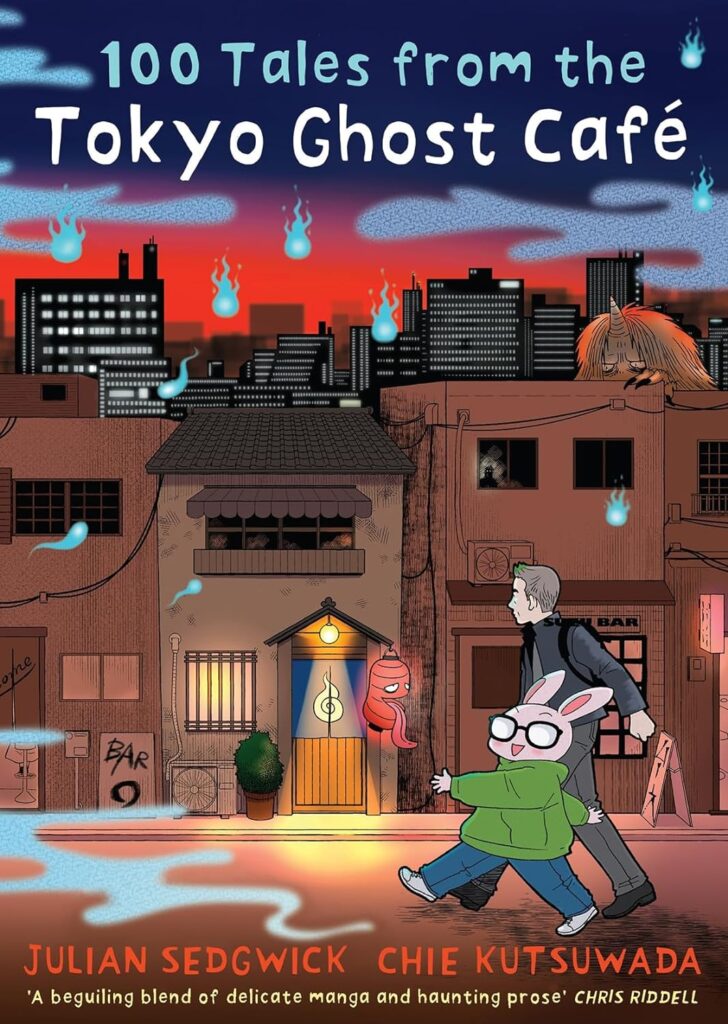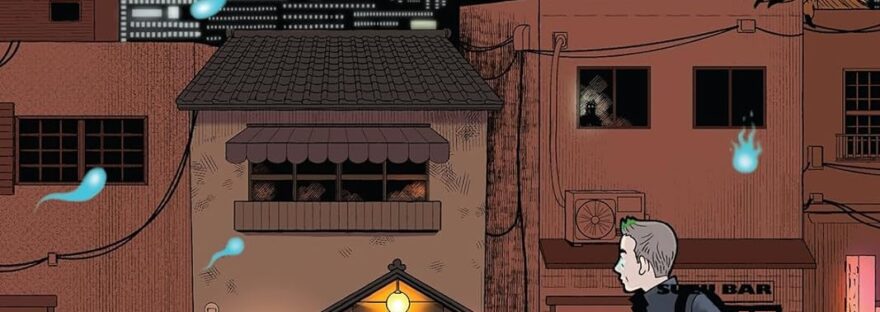By Julian Sedgwick and Chie Kutsuwada (published by Guppy Books, 2023)
“You think you can decide what is real and what is imaginary, what is alive and what is dead. But who is to decide who is alive and who is merely dreamed into existence? I listen to you lot argue about whether ghosts or fox spirits exist, and you forget to check how real you are.”
100 Tales from the Tokyo Ghost Café is a story of stories. The book alternates between prose chapters and manga sections; the latter tells the ongoing story of Julian and Chie, travelling across the north of Japan to collect ghost stories for a book. At the start of their journey, they meet a lost boy, Akira, who lives somewhere along their route, so they offer to get him home.

The prose sections are (mostly) a range of ghost stories, some set older, some recent, with a range of protagonists and themes. It is here that we are introduced to the various kami and yōkai recognised in Japan, how they manifest and what their intentions are.
Although it may not seem like it at first, every story – and the manga – is connected, whether this is a reference to or the appearance of a particular character, some familial relation that is revealed, or even the looming figures of the different yōkai.
This intertwining of the different characters and situations means you’ll likely want to read the book a second time, to see all the connections you may have missed on your first read. I personally did this immediately with the double spread picture of the Hyakkiyagyō, the Night Parade of 100 Demons, as I wanted to see which beings from later in the book were also there!
Tokyo Ghost Café is a real one-of-a-kind book…although that may not be completely accurate. Sedgwick and Kutsuwada have worked together before on 2021’s Tsunami Girl, based on the 2011 earthquake and tidal wave in Japan. Like this book, that was also prose with manga inserts, a format that obviously works well for the pair.
Tokyo Ghost Café even features a few of the characters from Tsunami Girl, and references the events and the tidal wave from the book. As someone who has not yet read the latter, I found their integration seamless; the characters are given their own roles in these stories, without getting swept up in details from the previous book, so the references can be followed with relative ease.
The stories themselves are a fascinating insight into the folklore and culture of Japan. They vary wildly between touching, creepy, funny, and “horror-lite”, which means you can never guess what’s coming next. I’m a big fan of spooky stories, and love learning about other cultures, so this book is right up my street!
We are given a few extras too, possibly because they knew it would have a large western audience. There is a basic map at the front that shows Julian and Chie’s route, decorated with various spirits and yōkai. Following the map, there is a brief introduction that explains the Japanese tradition of “100 Ghost Stories” that the title is based on, which gives the reader a quick sense of what to expect!
At the back of the book, there is a glossary for relevant Japanese words/phrases that are used, though most of the more common ones are given an explanation in the text where they appear. Having Japanese used throughout the story gives it a cultural and geographic grounding that I found became second nature to my reading.
Kutsuwada’s drawings are full of life and atmosphere, from the slightly awkward Julian, self-assured Chie (complete with rabbit ears!), and the young-but-determined Akira, to the friendly yūrei they meet and the malevolent tengu that stalks them. The landscapes feel by turns calm and ominous, and there is a subtlety layered in the images that causes you to search for shadows and faces in the background, or study certain figures more closely before moving on.
Some of the descriptions in the prose do feel like something out of Ghibli movie, but I feel that, if an animated film were produced (which I would love!), it would be only appropriate to use Kutsuwada’s drawings. The way she captures Sedgwick’s narrative cannot be denied as being the perfect fit.
When I reached the end, where Sedgwick and Kutsuwada bring everything together, I found myself with an almost longing ache, but also a feeling of peace, as if I had met and parted with old friends. And I immediately went back to spot what I had previously missed, including on the cover – I had been so drawn in by the shining blue onibi that I hadn’t paid attention to what might be in the shadows!
The weaving together of both the “real” and the “imaginary” (yes, even of the book itself – you’ll understand what I mean when you reach the end of chapter 9) within the short stories and the manga makes Tokyo Ghost Café an imaginative and engaging read, supported by the delightful main characters.
The chapters are relatively short, and the way it’s broken up with the illustrations makes this a great way to introduce children to aspects of Japanese culture they may not be familiar with. With themes of family and friendship, as well as history and belief, this is a thoughtful and intriguing book for children (and adults!) looking for something a bit different.
Do keep in mind that these are ghost stories however – there is nothing grotesque or graphic, but some of the stories do talk about death, abuse, etc., and not all the spirits are friendly, making this more suitable for older readers.
If you want to travel with Julian and Chie, you can grab a copy of 100 Tales from the Tokyo Ghost Café at the link below.
(Disclosure: If you buy books linked to our site, we may earn a commission from Bookshop.org, whose fees support independent bookshops.)
Looking for more books on folklore around the world? If so, you can see our previous reviews here.

